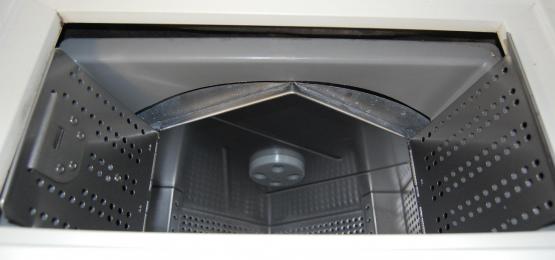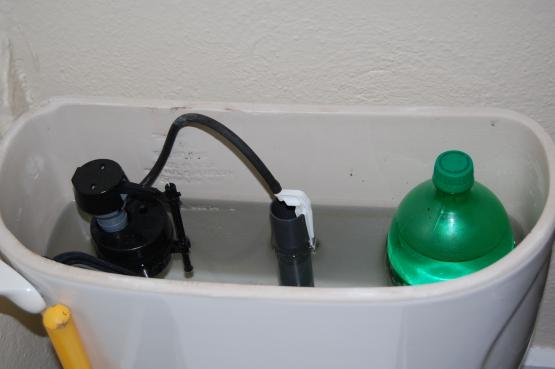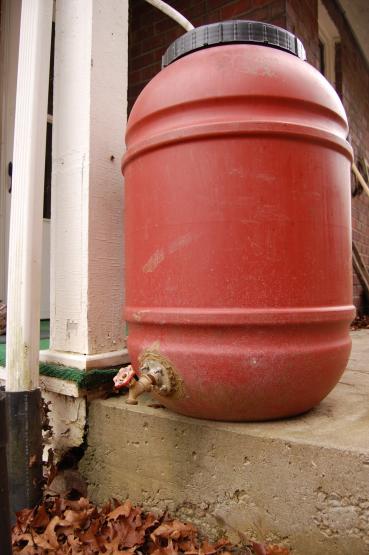
A-Maize-Ing Furnace
FURNACE | COMPOST | APPLIANCES | ENERGY EFFICIENCY | WATER CONSERVATION
The A-Maize-Ing Furnace
The "A-Maize-Ing Heat" biomass furnace (model number LDJ620-9 and LDJ620-10) runs on wood pellets, corn kernels (maize), or other biomass pellet fuel. A full load can keep the house heated for two weeks. The biomass furnace is only used when it is needed with the help of the programmable thermostat.
Currently the furnace uses wood pellets since corn was more expensive to use and its use as a fuel source was detracting from its service as a primary food source for our nation. The pellets can be made out of recycled wood, which can be considered a more sustainable practice than using corn. Just like any other furnace, the efficiency depends on temperature, time of year, oxygen intake, user efforts, etc.

The unit was purchased from an Iowa-based company, LDJ Manufacturing, Inc, for $3,650.
Wood as a fuel source can be a controversial discussion. Some believe burning wood is better for the environment than burning fossil fuels due to the comparably minimal release of greenhouse gases over the lifecycle of wood pellets. Some consider wood to be cleaner than coal for this reason. Particulate matter when burning coal is considered to be much worse than when burning wood. Though, burning wood still involves cutting down trees which leads to forest degradation and habitat loss. Additionally, burning wood still does release greenhouse gases. Wood is considered by many as a renewable resource (unlike fossil fuels), though some argue that the classification of wood as a renewable resource is dangerous since it may encourage deforestation and destruction of old growth trees. It also ignores the concern that cutting down trees causes captured carbon to be released into the atmosphere.
With all of these factors to consider, Ecohouse residents are given the opportunity to further explore energy options currently available and think about potential solutions to these problems.
Compost Bins
Composting is a process where organic matter decomposes at an accelerated rate. This is different from biodegrading because composting is accelerated due to a higher temperature and controlled environment. This is an aerobic process that requires the correct carbon to nitrogen ratio for proper breakdown to occur. Composting is temperature dependent and determines the speed at which the material breaks down. The Ecohouse is home to three different composting systems:
- Barrel Composter: Residents collect their kitchen scraps in a small bin in the house, empty that bin into a larger barrel, combine it with "brown waste" (such as newspaper or landscape waste) and then occasionally spin the barrel to aerate the contents. The resulting material is a nutrient-rich compost amendment that is used on the Ecohouse landscape instead of petroleum-based fertilizers.
- Worm Composting: A worm composting system is located in the basement of the Ecohouse. The framework for the system consists of a series of bins stacked vertically in which the worms reside. As they process the food waste and turn it into compost, they travel vertically through the bins. Moist newspaper is added to the bins in order to stabilize moisture for the worms. Residents add half of a pound of food per pound of worms.
- Heap Composting: The Ecohouse Community Garden features a heap composting unit for the gardeners to utilize. This is a simple open-air, three-bin system made out of used wood pallets. Gardeners are asked to use this composter for their unwanted/spoiled food and plant clippings. Weeds are dried by the sun on a tarp prior to being placed in the bins to avoid contamination of invasive species.
All three of the above options are viable options for any home composter. Supplies can be found locally.
Appliances
Refrigerator: The fridge/freezer at OHIO Ecohouse is Energy Star rated. The freezer is located on the bottom of the unit to maximize efficiency (since heat rises). The fridge is one of the most energy consumptive products in any home. So, residents are asked to keep both the fridge and freezer appropriately-stocked and ensure the doors are always tightly closed.
Dishwasher: The dishwasher's Energy Star rating is rated as being so efficient that it is off the Energy Star scale, and it is smaller than a standard dishwasher so it is more likely that it is full when it is in use. Ecohouse Residents wash most of their dishes by hand, but when they have guests over for potlucks and open houses, they use their Danby Designer dishwasher. Most dishwashers of a similar size use between 312kWh/yr to 573kWh/yr, but the Ecohouse dishwasher uses only 280kWh/yr
Washing Machine: Another Energy Star certified appliance, the washing machine uses significantly less water than a regular washing machine. It was manufactured by Staber Industries of Groveport, Ohio. In a large load, it uses approximately 16 gallons of water; a standard washer would use approximately 35 gallons. The machine is able to use significantly less water because it is a top loading horizontal-axis washer. It works like a front load washer in that it does not need to fill up as much because the clothes pass through the water constantly. However it is not actually a front load; there is a cage in the unit that can be opened from the top and locked in place. The model number for the washer is HXW2304. The dryer (although not Energy Star) was also purchased from Staber Industries because it is a local product. (Additionally, it's important to note that the clothes dryer is mostly used during the winter when the clothesline is difficult to use. The model for the dryer is HXD2304E.)

Compact Fluorescent Lightbulbs: While the house has plenty of natural lighting which is heavily utilized by residents, all Ecohouse light fixtures are equipped with compact fluorescent lightbulbs. Using compact fluorescent light bulbs (CFLs) can be the easiest way to save energy in the home. Although they have a higher up-front cost, they save much more in energy and replacement costs over their lifetimes. A CFL uses about 2/3 less energy than a standard incandescent one, and it can last from five to nine years. Most of the light fixtures use 13 or 23 watt CFLs that give off the same amount of light as a 60 or 100 watt incandescent bulb. The solar array produces enough energy to power about 185 13 watt CFLs compared to only 40 60 watt bulbs for one hour.
Energy Efficiency
Programmable Thermostat: This feature allows residents to heat or cool the house only when they are home, saving energy by eliminating unnecessary use of the furnace and air conditioning.
Whole House Fan: During the renovation process, the house received baffles, roof vents and an attic fan to take care of problematic air flow issues. The fan removes very hot air from the attic which eliminates the need for air conditioning.
Insulation: Ecohouse has been insulated with Nu-Wool blown cellulose and R19 in the attic, sidewalls, crawl space, and basement walls, which has increased efficiency significantly.
Water Conservation
Reduced water per flush: The toilet tank has a 2 liter bottle of water taking up space, thus reducing the amount of water used per flush.

Rainwater: The rain barrel on the back porch collects rainwater from the gutters. The water collected is used on the landscape and for household efforts such as flushing the toilet. There is also a rain collection unit attached to their solar panel near the garden, handy for watering the crops and plants nearby.

Low Flow Shower Head: The shower is equipped with a low-flow high-pressure showerhead that greatly reduces the amount of water consumed from showering.